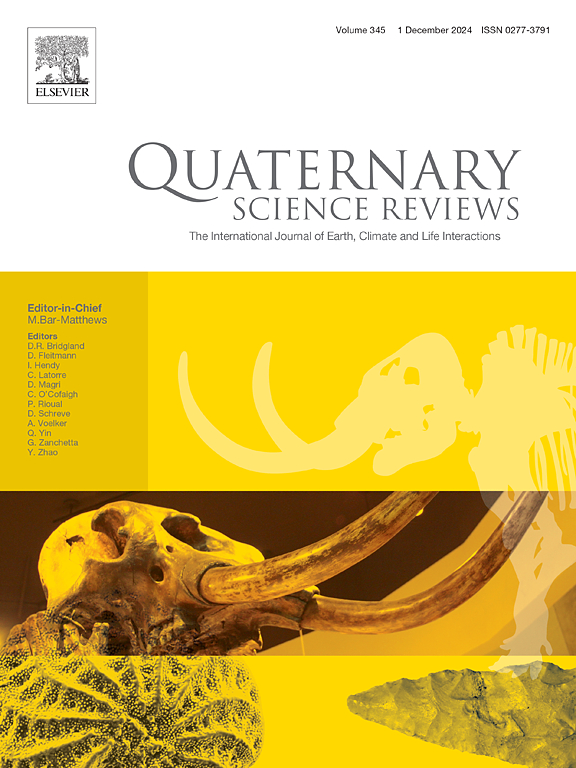末次盛冰期以来阿拉伯海西北部矿物粉尘作为初级生产力背后的强迫因素
IF 3.2
1区 地球科学
Q1 GEOGRAPHY, PHYSICAL
引用次数: 0
摘要
阿拉伯海(AS)位于印度洋西北部,受印度季风表面风的影响,夏季在索马里和阿曼附近形成沿海上升流,冬季在北纬15°以北形成对流混合。它周围还有大片的干旱地区,这些地区的风经常刮过,即沙马尔风和勒瓦尔风,它们向海面提供矿物粉尘。沿海上升流、对流混合和矿物粉尘为该区带来了大量的营养物质,使该区成为世界上最具生产力的海洋地区之一。末次盛冰期以来,许多研究将西部AS初级生产力的变化归因于沿海上升流和夏季风动力学的变化。然而,最近已经证明,对流混合是一个重要的贡献者在西北部的AS,而矿物粉尘可能也发挥了作用。文献中没有高分辨率的矿物粉尘记录,也没有与重建的PP信号相关联,这限制了我们对LGM以来该地区矿物粉尘与PP之间关系的理解。在本研究中,我们提供了位于AS西北部的MD00-2354(21°02.55'N, 61°28.51'E, 2740 mbsl)沉积物岩心碎屑组分粒度分布和粘土矿物学组成的亚千年尺度记录,这得益于先前基于微古生物方法获得的百年PP信号(Zhou et al., 2022)。结合研究地点的高分辨率地球化学x射线荧光(XRF)数据以及文献中的地球化学数据,这些记录使我们能够重建区域风动力学的变化,并将其与LGM以来的PP模式联系起来。大冰期和近冰期Henrich Stadial 1 (HS1);17-14.7 ka)和新仙女木(YD;12.9 ~ 11.7 ka)、更强的勒瓦和沙马尔、源区更强的干旱(与北半球冰盖扩大有关)、更弱的大西洋经向翻转环流(AMOC)和更强的冬季季风可能是造成西北地区较高的沙尘输入和PP信号的原因。全新世与温和期间Bølling-Allerød (B-A);14.7 ~ 12.9 ka)时,由于冰盖扩展减少,区域风减弱,源区湿度增强,AMOC增强,夏季风增强,似乎减少了矿物尘输入,从而降低了PP。在这些情景下,对流混合和矿物尘似乎是西北AS PP的主要营养来源,质疑该地区沿海上升流系统的影响。本文章由计算机程序翻译,如有差异,请以英文原文为准。
Mineral dust as a forcing factor behind primary productivity in the northwestern Arabian Sea since the Last Glacial Maximum
Located in the northwestern part of the Indian Ocean, the Arabian Sea (AS) is under the influence of Indian monsoon surface winds that create a coastal upwelling off Somalia and Oman during summer and a convective mixing north of 15°N during winter. It is also surrounded by vast arid regions regularly swept by regional winds, namely the Shamal and the Levar, that supply mineral dust to the sea surface. Coastal upwelling, convective mixing and mineral dust bring significant amount of nutrients to the euphotic zone, making the AS one of the most productive oceanic regions in the world. Since the Last Glacial Maximum (LGM), many studies attribute changes in western AS primary productivity (PP) to variations in coastal upwelling and summer monsoon dynamics. However, it has been recently demonstrated that convective mixing was a significant contributor in the northwestern part of the AS, while mineral dust may have also played a role. No high-resolution mineral dust records are available in the literature, nor are any linked to reconstructed PP signals, limiting our understanding of the relationship between mineral dust and PP in this region since the LGM. In this study, we provide sub-millennial scale records of detrital fraction grain-size distribution and clay mineralogy composition of sediment core MD00-2354 (21°02.55′N, 61°28.51′E, 2740 mbsl), located in the northwestern AS, and that benefits from a centennial PP signal previously obtained based on a micropaleontological approach (Zhou et al., 2022). Together with high-resolution geochemical X-ray fluorescence (XRF) data from the studied site as well as geochemical data from literature, these records enable us to reconstruct changes in regional wind dynamics and link them to PP patterns since the LGM. During the LGM and the near-glacial Henrich Stadial 1 (HS1; 17–14.7 ka) and Younger Dryas (YD; 12.9–11.7 ka), stronger Levar and Shamal together with stronger aridity in the source areas associated to more extended ice sheet in the Northern Hemisphere, weaker Atlantic Meridional Overturning Circulation (AMOC), and stronger winter monsoon, seem to be responsible for the higher dust inputs and PP signals recorded in the northwestern AS. During the Holocene and the mild interstadial Bølling-Allerød (B-A; 14.7–12.9 ka), weaker regional winds together with stronger humidity in the source area due to reduced ice sheet extension, stronger AMOC, and stronger summer monsoon, seem to diminish mineral dust inputs and hence lower PP. In such scenarios, convective mixing and mineral dust appear to be the main nutrient sources for PP in the northwestern AS, questioning the influence of the coastal upwelling system in that area.
求助全文
通过发布文献求助,成功后即可免费获取论文全文。
去求助
来源期刊

Quaternary Science Reviews
地学-地球科学综合
CiteScore
7.50
自引率
15.00%
发文量
388
审稿时长
3 months
期刊介绍:
Quaternary Science Reviews caters for all aspects of Quaternary science, and includes, for example, geology, geomorphology, geography, archaeology, soil science, palaeobotany, palaeontology, palaeoclimatology and the full range of applicable dating methods. The dividing line between what constitutes the review paper and one which contains new original data is not easy to establish, so QSR also publishes papers with new data especially if these perform a review function. All the Quaternary sciences are changing rapidly and subject to re-evaluation as the pace of discovery quickens; thus the diverse but comprehensive role of Quaternary Science Reviews keeps readers abreast of the wider issues relating to new developments in the field.
 求助内容:
求助内容: 应助结果提醒方式:
应助结果提醒方式:


